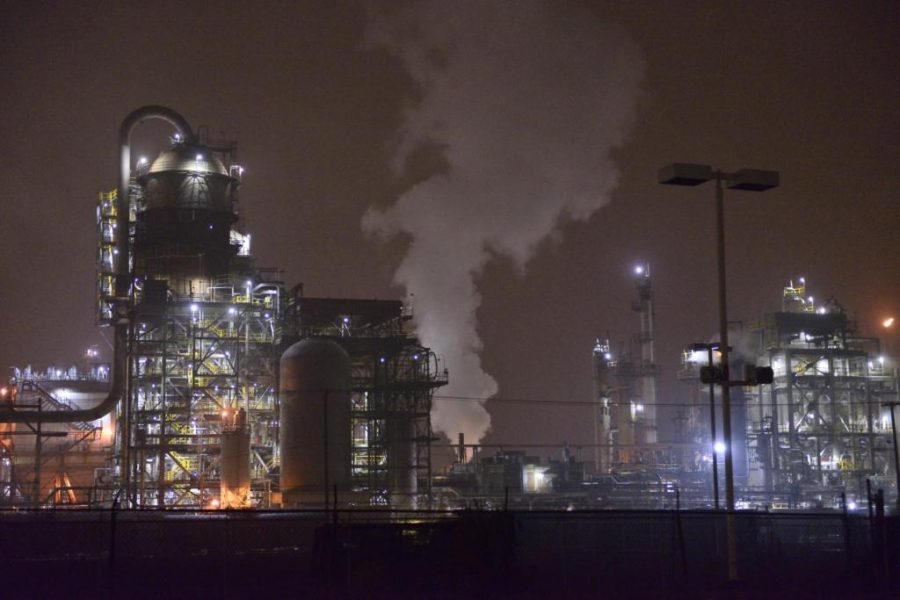As the cold winter months approach, members of the University of Utah campus community are dreading the smoggy days to come.
“I’d say it’s a problem,” said civil engineering student Lydia Monkmeyer.
The inversion has plagued the Salt Lake Valley for decades, impacting health and day-to-day life for residents. The chronic air-quality problem is common knowledge, but not everyone fully understands how it is created or its effects.
Inversion is a weather phenomenon caused by the bowl-like shape of the Salt Lake Valley, settled within a rim of towering mountains. It happens when cold air is trapped in the valley by warmer air, which sits on top. Because the warm and cold air do not mix easily, pollution emitted within the valley gets trapped in the cold air and can’t escape.
Though inversion is not unique to Utah, a few factors make it especially prevalent in the state. Contrary to what many residents believe, the inversion is not the result of gases, but floating particulate matter in the air. The particulates are small, often fewer than 2.5 micrometers, and they can’t leave until a storm cycle or wind blows the warm air away. The particulate matter is the gray smog that can be seen in the air. It gets in people’s lungs, it causes them to cough and sneeze, and oftentimes people have trouble breathing.
Causes
Common air pollutants that plague the Salt Lake Valley during winter inversions include carbon monoxide, ozone, nitrogen dioxide, sulfur dioxide, lead and the most common PM 2.5 (floating particulate matter). These are produced by a variety of factors, including excessive car-driving and high electricity use in homes.
Pollutants are emitted by burning fuels like coal, gas or diesel. This releases floating particulate matter, along with other chemicals, into the Salt Lake Valley’s air.
According to a statement by Breathe Utah, a local nonprofit seeking solutions to bad air quality, “Nearly 100 percent of PM 2.5 in Utah comes from consuming one of three fuels — gasoline, diesel and coal. When an inversion is forecast or the PM 2.5 level is rising and no storm is on the horizon, reduce your fuel consumption.”
Negative Health Impacts
The World Health Organization has estimated that 3.7 million people each year die from the effects of air pollution. Common health problems that contribute to this statistic include asthma, common obstructive pulmonary disease (COPD), heart disease, heart attacks and birth defects. It has also been linked to pneumonia, lung cancer and bronchitis.
“Both short term and long term exposure to air pollution causes problems,” said Robert Paine III, chief of pulmonary and critical care medicine at the University of Utah hospital, in a recent press release. “Long term exposure to poor air quality causes lots of different kinds of health problems and also earlier death. But we also know that if we expose people to air pollution even for short periods of time, we see physiological changes — we’ll see lung function and cardiac status get worse.”
A group of Utah physicians recently became alarmed by studies which showed an increase in deaths linked to air pollution exposure. Motivated by this data, doctors in 2017 started pressing for action to combat the impacts of air pollution on their patients.
“There is no safe level of air pollution that we can inhale,” said Brian Moench, president of Utah Physicians in a July 2017 article by The Salt Lake Tribune. “So if there is a standard, it’s arbitrary.”
Studies have been conducted by multiple institutions demonstrating that people who are chronically exposed to low-dose air pollution are more likely to die a premature death, often resulting from lung and cardiac issues. Looking at a focus group of those 65 years and older, researchers found that every 10 micrograms of particulate matter per cubic meter of air increases chances of a premature death increased by 7.3 percent, according to The New England Journal of Medicine.
Another study published in the International Journal of Environmental Research and Public Health showed that ozone exposure can cause pregnancy loss. Women exposed to ozone shortly before delivery had a 13 to 22 percent higher chance of stillbirth.
How to Help Reduce Inversion
Multiple organizations at the U, including the Office of Sustainability and the Atmospheric Sciences and Health Sciences Departments, have offered potential solutions to the inversion. Many of them include the personal choices of individuals within the city. They suggest residents:
- Limit fireplace usage — especially those with a wood-burning fireplace.
- Decrease use of heat inside homes.
- Turn cars off instead of idling.
- Carpool, take public transit, walk or ride a bike. Fewer cars on the road eases traffic, decreases the number of idling vehicles and reduces overall pollution.
- Combine all errands into one trip to save time and reduce emissions.
- Accelerate slowly and drive the speed limit. (Speed burns more fuel.)
- Use less coal, which is primarily used for electricity. (Turn off lights when they aren’t being used.)
How to Stay Healthy During Inversion
Personal choices certainly won’t decrease the inversion right way, so in the meantime students and experts alike are looking for ways to protect themselves from being affected by the poor air quality.
“When the inversion is bad, I tend to lock myself indoors and drive to places rather than take my bike or walk,” said Christopher Payne, an entertainment arts student at the U.
Though biking and walking are better for the environment, it’s unsafe to be exercising outside when air quality is so bad. U Healthcare has recommended people:
- Avoid exercising outside during inversion.Exercise prompts the need for deeper breaths, which causes more particulate matter to enter the lungs. People can avoid this by working out inside.
- Avoid being outside if possible, as just walking around in inversion can be detrimental to lungs.
- If exercising outside is a necessity, a mask should be worn to help filter out the pollution.
c.macdonald@dailyutahchronicle.com


